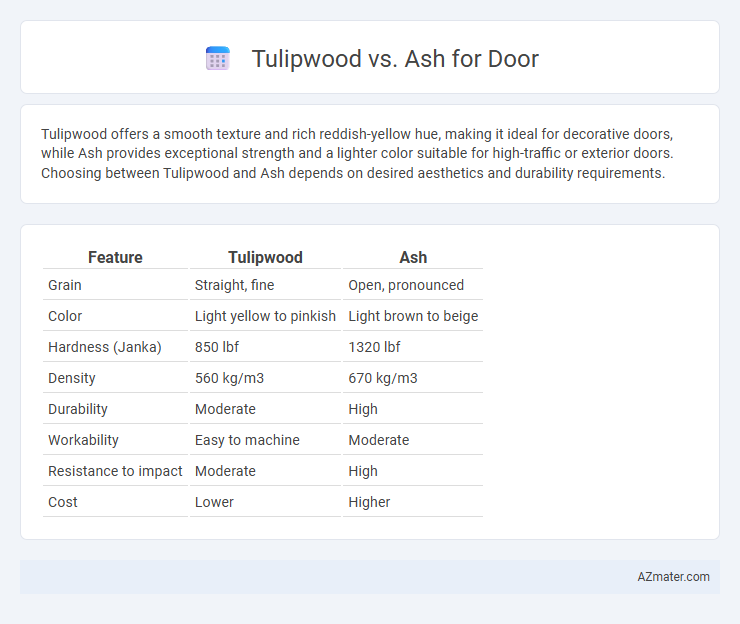Tulipwood offers a smooth texture and rich reddish-yellow hue, making it ideal for decorative doors, while Ash provides exceptional strength and a lighter color suitable for high-traffic or exterior doors. Choosing between Tulipwood and Ash depends on desired aesthetics and durability requirements.
Table of Comparison
| Feature | Tulipwood | Ash |
|---|---|---|
| Grain | Straight, fine | Open, pronounced |
| Color | Light yellow to pinkish | Light brown to beige |
| Hardness (Janka) | 850 lbf | 1320 lbf |
| Density | 560 kg/m3 | 670 kg/m3 |
| Durability | Moderate | High |
| Workability | Easy to machine | Moderate |
| Resistance to impact | Moderate | High |
| Cost | Lower | Higher |
Introduction to Tulipwood and Ash
Tulipwood, known for its smooth texture and pale pink to reddish hues, offers durability and a fine grain ideal for elegant door designs. Ash wood features a light color with prominent grain patterns, prized for its strength and flexibility in crafting sturdy, attractive doors. Both woods bring unique aesthetic and structural qualities, making them popular choices in high-quality door manufacturing.
Wood Characteristics and Appearance
Tulipwood features a fine, straight grain with a creamy yellow to light reddish-brown hue, offering a smooth texture that ages to a deeper, rich color, making it ideal for elegant door designs. Ash is characterized by its pronounced open grain and light beige to pale brown color, providing excellent strength and shock resistance suitable for sturdy, traditional doors. Both woods are durable, but tulipwood's finer grain gives a more polished appearance, while ash presents a rustic, natural look with higher impact resilience.
Durability and Strength Comparison
Tulipwood offers moderate durability with a Janka hardness rating around 950, making it suitable for interior doors but less resistant to heavy impact compared to ash. Ash wood boasts a higher Janka hardness of approximately 1320, providing superior strength and excellent shock resistance, ideal for doors exposed to frequent use or potential damage. Both woods have good dimensional stability, but ash's greater tensile strength ensures longer-lasting performance in high-traffic door applications.
Workability and Ease of Machining
Tulipwood offers excellent workability with its straight grain and moderate density, making it easy to machine and shape for door applications. Ash, known for its toughness and flexibility, machines smoothly but requires sharper tools due to its coarser grain and higher density. Both woods hold fasteners well, but tulipwood's consistent texture provides a slight edge in ease of machining and achieving fine detailing on doors.
Cost and Availability
Tulipwood offers a lower cost alternative compared to ash, making it a budget-friendly option for door construction without compromising on durability. Ash is generally more expensive due to its higher demand and slower growth rate, resulting in limited availability in some regions. Tulipwood is widely available in North America, ensuring easier procurement and consistent pricing for door manufacturers.
Environmental Impact and Sustainability
Tulipwood, sourced primarily from fast-growing Liriodendron trees, offers a more sustainable choice for doors due to its rapid renewal rate and lower harvesting impact compared to Ash, which grows slower and requires longer growth cycles. Ash, while durable, often contributes to deforestation concerns and habitat disruption owing to its slower regrowth and higher demand in traditional woodworking. Choosing Tulipwood supports reduced carbon footprints and promotes environmentally responsible forestry management, aligning with eco-friendly construction practices.
Finishing and Staining Qualities
Tulipwood offers a smooth, fine grain that accepts stains evenly, resulting in a consistent finish ideal for achieving rich, vibrant colors on doors. Ash features a more pronounced grain pattern that enhances staining depth and texture, providing a natural, rustic look while still allowing for uniform stain absorption. Both woods respond well to finishing techniques, but Tulipwood's lighter, closed grain makes it preferable for sleek, modern door designs, whereas Ash suits finishes emphasizing natural wood character.
Common Applications in Door Manufacturing
Tulipwood is frequently used in door manufacturing for its attractive grain and smooth finish, making it ideal for decorative interior doors and veneer applications. Ash offers superior strength and durability, making it a preferred choice for high-traffic exterior doors and solid-core doors requiring structural integrity. Both woods balance aesthetics and performance, with tulipwood favored for visual appeal and ash known for resilience in everyday use.
Maintenance and Longevity
Tulipwood doors require less frequent maintenance due to their natural resistance to decay and insect damage, providing a durable option for long-term use. Ash doors offer excellent toughness and can withstand heavy wear, but they need more regular sealing and refinishing to prevent moisture absorption and warping. Both woods provide longevity when properly maintained, with Tulipwood often favored for lower upkeep in humid environments.
Choosing the Best Wood for Your Door
Tulipwood offers a smooth texture and subtle grain, making it ideal for sleek, modern door designs, while ash provides exceptional strength and a striking grain pattern suited for more traditional or rustic doors. Ash's durability and resistance to wear make it a superior choice for high-traffic areas, whereas tulipwood is lighter and easier to work with, perfect for intricate detailing. Selecting between tulipwood and ash depends on the desired aesthetic, durability requirements, and the specific environmental conditions where the door will be installed.

Infographic: Tulipwood vs Ash for Door
 azmater.com
azmater.com